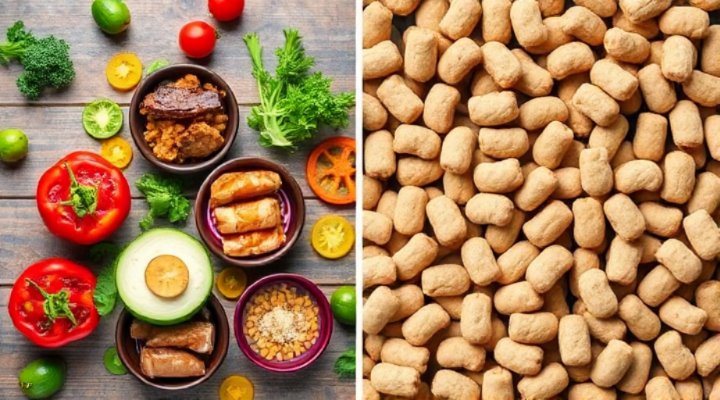When it comes to our canine companions, we all want what’s best for them. That’s why more pet owners are discovering the fresh dog food benefits that can transform their pet’s health and wellbeing. Unlike processed kibble that’s been sitting on shelves for months, fresh dog food offers living nutrition that’s closer to what dogs would eat in nature.

Why Fresh Ingredients Matter for Your Dog’s Health
First and foremost, fresh dog food retains more of its natural nutrients. Processing and preservatives in commercial kibble can destroy up to 60% of the original food’s nutritional value. That means your dog might be missing out on essential vitamins, minerals, and enzymes that support everything from digestion to immune function.
For example, when I switched my Labrador Max to fresh food, I noticed his coat became shinier within weeks, his energy levels improved, and his occasional digestive issues disappeared. Many veterinarians report similar transformations in their patients when they make the switch to fresh diets.

The Digestive Benefits of Fresh Dog Food
One of the most significant fresh dog food benefits is improved digestion. Dogs’ digestive systems haven’t evolved much from their wild ancestors, who ate fresh kills and foraged foods. Processed kibble, while convenient, can be hard on their systems.
Fresh ingredients are more bioavailable, meaning your dog’s body can absorb and utilize the nutrients more effectively. This leads to smaller, firmer stools (any dog owner will appreciate that!) and better nutrient absorption. If you’ve ever struggled with digestive issues in your dog, fresh food might be the solution you’ve been looking for.
How Fresh Food Supports Long-Term Health
Beyond immediate benefits, fresh dog food can contribute to your pet’s long-term wellness. Studies show that dogs fed fresh, whole-food diets tend to have:
- Healthier skin and coats
- Stronger immune systems
- Better weight management
- Reduced allergy symptoms
- Improved dental health
The American Veterinary Medical Association acknowledges that diet plays a crucial role in canine health, and many veterinarians are now recommending fresh food options.

Making the Switch to Fresh Dog Food
Transitioning to fresh food doesn’t have to be complicated. Here are some tips I’ve learned from experience:
- Start by mixing a small amount of fresh food with your dog’s current diet
- Gradually increase the fresh portion over 7-10 days
- Monitor your dog’s reaction (energy levels, stool quality, etc.)
- Consult with your veterinarian about proper portion sizes
Remember, just like with training techniques, every dog is different. What works for one might need adjustment for another.
Fresh Food Options for Every Budget
Contrary to popular belief, fresh dog food doesn’t have to break the bank. While premium commercial fresh food services exist, you can also prepare simple fresh meals at home with guidance from your vet. Some cost-effective options include:
- Rotating protein sources based on what’s on sale
- Buying seasonal vegetables
- Preparing larger batches and freezing portions
The USDA Food and Nutrition Information Center offers resources on safe food handling and preparation that can be helpful for pet owners venturing into homemade meals.

Special Considerations for Senior Dogs
Older dogs can particularly benefit from fresh food’s easily digestible nutrients. As dogs age, their ability to process certain foods decreases, making fresh, simple ingredients ideal. Many senior dog owners report improved mobility and cognitive function after switching to fresh diets.
If you’re caring for an aging pet, you might also find our guide on specialized care techniques helpful alongside dietary changes.
Common Myths About Fresh Dog Food
Let’s address some misconceptions:
Myth: Fresh food is inconvenient.
Fact: Many fresh food services deliver pre-portioned meals, and simple homemade options can be quicker to prepare than you think.
Myth: Kibble cleans dogs’ teeth better.
Fact: Most kibble doesn’t actually clean teeth effectively. Fresh food eaters often have better dental health when combined with proper dental care.
Myth: Fresh diets aren’t nutritionally complete.
Fact: With proper formulation (either commercial or vet-approved homemade), fresh diets can meet all your dog’s nutritional needs.
The Bottom Line on Fresh Dog Food Benefits
While fresh dog food might require slightly more effort than pouring kibble from a bag, the health benefits make it worthwhile for many pet owners. From shinier coats to improved digestion and potentially longer lifespans, the advantages are compelling.
As with any dietary change, consult with your veterinarian, especially if your dog has existing health conditions. But for many dogs, fresh food can be a game-changer in their quality of life.
Ready to explore fresh food options? Start by checking out our comprehensive pet care resources for more tips on keeping your dog healthy and happy.
Related Keywords: fresh dog food recipes, best fresh dog food brands, homemade dog food benefits, raw dog food vs fresh, transitioning to fresh dog food
